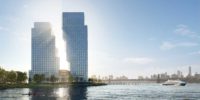Sponge-Worthy Design for the Gowanus Canal in Brooklyn

Image courtesy DLANDstudio

Image courtesy DLANDstudio

Image courtesy DLANDstudio



A tiny new park in Brooklyn has a big job: absorbing and filtering a million gallons of stormwater each year that flows into one of the most putrid waterways in the United States. Located at the end of Second Street on the western side of the Gowanus Canal, the Sponge Park, as it is called, was designed to address decades of environmental degradation of the Gowanus and serve as a prototype for other green infrastructure projects.
Like many older cities in the U.S., New York has a combined stormwater and sewer system. During major storms, the system becomes overwhelmed and untreated water—including sewage—runs into the city’s rivers and water passages, like the Gowanus. These overflows and decades of industrial pollution have helped make the canal one of the nation’s most toxic. Under an agreement with the Environmental Protection Agency, New York is bound to drastically reduce the combined sewage overflows, which will improve water quality in the region and beyond.
Further, the Gowanus is classified as a Superfund Site, a federal-designation for the most polluted lands in the U.S. A clean-up process is currently underway there, and the Sponge Park will help prevent additional pollution from entering the canal.
Designed by DLANDstudio, a Brooklyn-based landscape architecture and urban design firm, the park collects and absorbs stormwater from the street through two channels under the sidewalk. Rows of woody plants, which were selected for their phytoremediative qualities, will help filter and clean the water. Stainless steel gratings are used to create walkways over the rain gardens, which are held in below-grade precast concrete tubs.
The $1.4 million project was funded by the variety of city and regional agencies through grants, which DLANDstudio put together.
“We realized that the street-ends are owned by the city, and that they could be working better for people and the environment,” says Susannah Drake, the principal of DLANDstudio. “Taken together they could form a whole new system of green infrastructure.”
Drake and her colleagues have identified nearly 200 similar street-end sites around the city near other waterways including Newtown Creek, an estuary that forms the border between Brooklyn and Queens, and in New York’s Rockaway region. The Sponge Park’s performance will be monitored as the city considers other possible locations for similar projects. “I’m excited about it as a something that can be replicated— the idea that you can use these elements in the urban landscape in a more pervasive way to have a huge impact,” Drake says.







